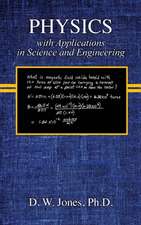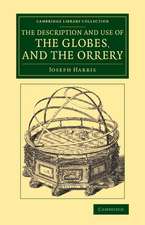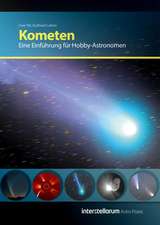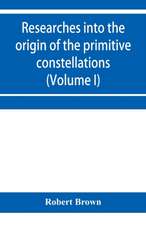The Music of the Big Bang: The Cosmic Microwave Background and the New Cosmology: Astronomers' Universe
Autor Amedeo Balbien Limba Engleză Hardback – 9 oct 2008
| Toate formatele și edițiile | Preț | Express |
|---|---|---|
| Paperback (1) | 153.80 lei 22-36 zile | |
| Springer Berlin, Heidelberg – 18 noi 2010 | 153.80 lei 22-36 zile | |
| Hardback (1) | 210.44 lei 22-36 zile | |
| Springer Berlin, Heidelberg – 9 oct 2008 | 210.44 lei 22-36 zile |
Din seria Astronomers' Universe
-
 Preț: 207.15 lei
Preț: 207.15 lei -
 Preț: 195.53 lei
Preț: 195.53 lei -
 Preț: 254.90 lei
Preț: 254.90 lei -
 Preț: 259.27 lei
Preț: 259.27 lei -
 Preț: 212.88 lei
Preț: 212.88 lei -
 Preț: 256.41 lei
Preț: 256.41 lei -
 Preț: 264.35 lei
Preț: 264.35 lei -
 Preț: 259.08 lei
Preț: 259.08 lei -
 Preț: 227.61 lei
Preț: 227.61 lei -
 Preț: 277.98 lei
Preț: 277.98 lei -
 Preț: 305.70 lei
Preț: 305.70 lei -
 Preț: 253.11 lei
Preț: 253.11 lei -
 Preț: 216.60 lei
Preț: 216.60 lei -
 Preț: 272.24 lei
Preț: 272.24 lei -
 Preț: 330.75 lei
Preț: 330.75 lei -
 Preț: 179.00 lei
Preț: 179.00 lei -
 Preț: 289.83 lei
Preț: 289.83 lei -
 Preț: 160.03 lei
Preț: 160.03 lei -
 Preț: 200.80 lei
Preț: 200.80 lei -
 Preț: 255.97 lei
Preț: 255.97 lei -
 Preț: 242.58 lei
Preț: 242.58 lei -
 Preț: 262.55 lei
Preț: 262.55 lei -
 Preț: 257.08 lei
Preț: 257.08 lei -
 Preț: 187.82 lei
Preț: 187.82 lei -
 Preț: 225.19 lei
Preț: 225.19 lei -
 Preț: 207.64 lei
Preț: 207.64 lei -
 Preț: 104.35 lei
Preț: 104.35 lei -
 Preț: 188.94 lei
Preț: 188.94 lei -
 Preț: 270.49 lei
Preț: 270.49 lei -
 Preț: 212.01 lei
Preț: 212.01 lei -
 Preț: 169.08 lei
Preț: 169.08 lei -
 Preț: 210.01 lei
Preț: 210.01 lei -
 Preț: 208.26 lei
Preț: 208.26 lei -
 Preț: 253.98 lei
Preț: 253.98 lei -
 Preț: 180.12 lei
Preț: 180.12 lei -
 Preț: 254.90 lei
Preț: 254.90 lei -
 Preț: 247.82 lei
Preț: 247.82 lei -
 Preț: 207.39 lei
Preț: 207.39 lei -
 Preț: 208.70 lei
Preț: 208.70 lei -
 Preț: 214.86 lei
Preț: 214.86 lei -
 Preț: 188.94 lei
Preț: 188.94 lei -
 Preț: 194.65 lei
Preț: 194.65 lei -
 Preț: 277.34 lei
Preț: 277.34 lei -
 Preț: 187.15 lei
Preț: 187.15 lei -
 Preț: 210.93 lei
Preț: 210.93 lei -
 Preț: 212.01 lei
Preț: 212.01 lei
Preț: 210.44 lei
Nou
Puncte Express: 316
Preț estimativ în valută:
40.27€ • 42.15$ • 33.52£
40.27€ • 42.15$ • 33.52£
Carte disponibilă
Livrare economică 10-24 martie
Preluare comenzi: 021 569.72.76
Specificații
ISBN-13: 9783540787266
ISBN-10: 3540787267
Pagini: 176
Ilustrații: XVI, 160 p. 41 illus.
Dimensiuni: 155 x 235 x 15 mm
Greutate: 0.38 kg
Ediția:2008
Editura: Springer Berlin, Heidelberg
Colecția Springer
Seria Astronomers' Universe
Locul publicării:Berlin, Heidelberg, Germany
ISBN-10: 3540787267
Pagini: 176
Ilustrații: XVI, 160 p. 41 illus.
Dimensiuni: 155 x 235 x 15 mm
Greutate: 0.38 kg
Ediția:2008
Editura: Springer Berlin, Heidelberg
Colecția Springer
Seria Astronomers' Universe
Locul publicării:Berlin, Heidelberg, Germany
Public țintă
Popular/generalCuprins
Prologue.- The framework (an introduction to the Big Bang model).- First light (an introduction to the cosmic background radiation - CMB).- Cosmic seeds (structure formation in the Universe and the CMB).- Music of the spheres (acoustic oscillations in the primordial Universe).- Finding harmony (the discovery of acoustic oscillations in the CMB power spectrum).- The undiscovered country (some future prospects).- Epilogue.
Recenzii
From the reviews:
"Balbi … is currently working on a satellite experiment to further study the CMB. His well-written book follows the ways in which the CMB has been used to understand the universe. … he gives a very readable account of current cosmological thought, especially for general readers. Summing Up: Recommended. All undergraduate and public libraries." (A. Spero, Choice, Vol. 46 (9), May, 2009)
"Balbi … is currently working on a satellite experiment to further study the CMB. His well-written book follows the ways in which the CMB has been used to understand the universe. … he gives a very readable account of current cosmological thought, especially for general readers. Summing Up: Recommended. All undergraduate and public libraries." (A. Spero, Choice, Vol. 46 (9), May, 2009)
Notă biografică
Amedeo Balbi is a researcher in cosmology at the Department of Physics of the University of Rome Tor Vergata. In the past, he worked at the University of California at Berkeley with George Smoot (Nobel Prize 2006 in Physics). Currently, he is involved in the preparation of ESA's forthcoming Planck satellite mission.
Textul de pe ultima copertă
The cosmic microwave background radiation is the afterglow of the big bang: a tenuous signal, more than 13 billion years old, which carries the answers to many of the questions about the nature of our Universe. It was serendipitously discovered in 1964, and thoroughly investigated in the last four decades by a large number of experiments. Two Nobel Prizes in Physics have already been awarded for research on the cosmic background radiation: one in 1978 to Arno Penzias and Robert Wilson, who first discovered it, the other in 2006, to George Smoot and John Mather, for the results of the COBE satellite.
Most cosmological information is encoded in the cosmic background radiation by acoustic oscillations in the dense plasma that filled the primordial Universe: a "music" of the big bang, which cosmologists have long been trying to reconstruct and analyze, in order to distinguish different cosmological models, much like one can distinguish different musical instruments by their timbre and overtones. Only lately, this amazing cosmic sound has been unveiled by such experiments as BOOMERANG and MAXIMA and, more recently, by the WMAP satellite. This led to a giant leap in our understanding of the Universe, but the investigation is not ended yet.
The book focuses on how the exploration of the cosmic background radiation has shaped our picture of the Universe, leading even the non-specialized readers towards the frontier of cosmological research, helping them to understand, using a simple language and captivating metaphors, the mechanisms behind the Universe in which we live.
"This non-technical tour of the discovery and significance of the whispers of creation, the fossil radiation from the Big Bang, is a delight to read." Prof. Joe Silk, University of Oxford, a pioneering contributor to understanding the structure of the cosmic background radiation.
Most cosmological information is encoded in the cosmic background radiation by acoustic oscillations in the dense plasma that filled the primordial Universe: a "music" of the big bang, which cosmologists have long been trying to reconstruct and analyze, in order to distinguish different cosmological models, much like one can distinguish different musical instruments by their timbre and overtones. Only lately, this amazing cosmic sound has been unveiled by such experiments as BOOMERANG and MAXIMA and, more recently, by the WMAP satellite. This led to a giant leap in our understanding of the Universe, but the investigation is not ended yet.
The book focuses on how the exploration of the cosmic background radiation has shaped our picture of the Universe, leading even the non-specialized readers towards the frontier of cosmological research, helping them to understand, using a simple language and captivating metaphors, the mechanisms behind the Universe in which we live.
"This non-technical tour of the discovery and significance of the whispers of creation, the fossil radiation from the Big Bang, is a delight to read." Prof. Joe Silk, University of Oxford, a pioneering contributor to understanding the structure of the cosmic background radiation.
Caracteristici
Explains, in simple terms, the discovery and significance of the cosmic background radiation Makes this vital window onto the early universe accessible to general readers













